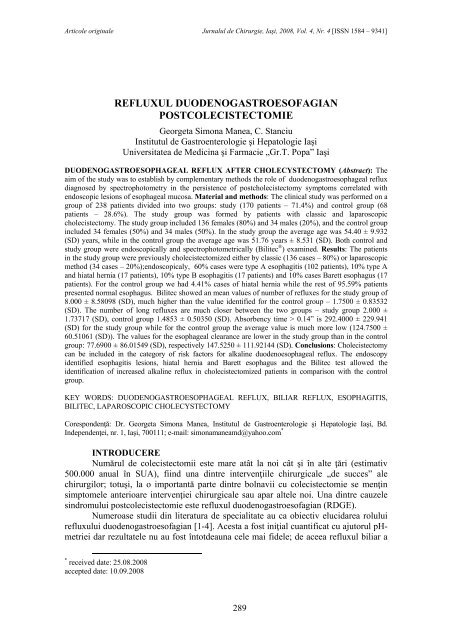Full text PDF (6.1 MB) - Jurnalul de Chirurgie
Full text PDF (6.1 MB) - Jurnalul de Chirurgie
Full text PDF (6.1 MB) - Jurnalul de Chirurgie
You also want an ePaper? Increase the reach of your titles
YUMPU automatically turns print PDFs into web optimized ePapers that Google loves.
Articole originale <strong>Jurnalul</strong> <strong>de</strong> <strong>Chirurgie</strong>, Iaşi, 2008, Vol. 4, Nr. 4 [ISSN 1584 – 9341]<br />
REFLUXUL DUODENOGASTROESOFAGIAN<br />
POSTCOLECISTECTOMIE<br />
Georgeta Simona Manea, C. Stanciu<br />
Institutul <strong>de</strong> Gastroenterologie şi Hepatologie Iaşi<br />
Universitatea <strong>de</strong> Medicina şi Farmacie „Gr.T. Popa” Iaşi<br />
DUODENOGASTROESOPHAGEAL REFLUX AFTER CHOLECYSTECTOMY (Abstract): The<br />
aim of the study was to establish by complementary methods the role of duo<strong>de</strong>nogastroesophageal reflux<br />
diagnosed by spectrophotometry in the persistence of postcholecistectomy symptoms correlated with<br />
endoscopic lesions of esophageal mucosa. Material and methods: The clinical study was performed on a<br />
group of 238 patients divi<strong>de</strong>d into two groups: study (170 patients – 71.4%) and control group (68<br />
patients – 28.6%). The study group was formed by patients with classic and laparoscopic<br />
cholecistectomy. The study group inclu<strong>de</strong>d 136 females (80%) and 34 males (20%), and the control group<br />
inclu<strong>de</strong>d 34 females (50%) and 34 males (50%). In the study group the average age was 54.40 ± 9.932<br />
(SD) years, while in the control group the average age was 51.76 years ± 8.531 (SD). Both control and<br />
study group were endoscopically and spectrophotometrically (Bilitec ® ) examined. Results: The patients<br />
in the study group were previously cholecistectomized either by classic (136 cases – 80%) or laparoscopic<br />
method (34 cases – 20%);endoscopicaly, 60% cases were type A esophagitis (102 patients), 10% type A<br />
and hiatal hernia (17 patients), 10% type B esophagitis (17 patients) and 10% cases Barett esophagus (17<br />
patients). For the control group we had 4.41% cases of hiatal hernia while the rest of 95.59% patients<br />
presented normal esophagus. Bilitec showed an mean values of number of refluxes for the study group of<br />
8.000 ± 8.58098 (SD), much higher than the value i<strong>de</strong>ntified for the control group – 1.7500 ± 0.83532<br />
(SD). The number of long refluxes are much closer between the two groups – study group 2.000 ±<br />
1.73717 (SD), control group 1.4853 ± 0.50350 (SD). Absorbency time > 0.14” is 292.4000 ± 229.941<br />
(SD) for the study group while for the control group the average value is much more low (124.7500 ±<br />
60.51061 (SD)). The values for the esophageal clearance are lower in the study group than in the control<br />
group: 77.6900 ± 86.01549 (SD), respectively 147.5250 ± 111.92144 (SD). Conclusions: Cholecistectomy<br />
can be inclu<strong>de</strong>d in the category of risk factors for alkaline duo<strong>de</strong>noesophageal reflux. The endoscopy<br />
i<strong>de</strong>ntified esophagitis lesions, hiatal hernia and Barett esophagus and the Bilitec test allowed the<br />
i<strong>de</strong>ntification of increased alkaline reflux in cholecistectomized patients in comparison with the control<br />
group.<br />
KEY WORDS: DUODENOGASTROESOPHAGEAL REFLUX, BILIAR REFLUX, ESOPHAGITIS,<br />
BILITEC, LAPAROSCOPIC CHOLECYSTECTOMY<br />
Corespon<strong>de</strong>nţă: Dr. Georgeta Simona Manea, Institutul <strong>de</strong> Gastroenterologie şi Hepatologie Iaşi, Bd.<br />
In<strong>de</strong>pen<strong>de</strong>nţei, nr. 1, Iaşi, 700111; e-mail: simonamaneamd@yahoo.com *<br />
INTRODUCERE<br />
Numărul <strong>de</strong> colecistectomii este mare atât la noi cât şi în alte ţări (estimativ<br />
500.000 anual în SUA), fiind una dintre intervenţiile chirurgicale „<strong>de</strong> succes” ale<br />
chirurgilor; totuşi, la o importantă parte dintre bolnavii cu colecistectomie se menţin<br />
simptomele anterioare intervenţiei chirurgicale sau apar altele noi. Una dintre cauzele<br />
sindromului postcolecistectomie este refluxul duo<strong>de</strong>nogastroesofagian (RDGE).<br />
Numeroase studii din literatura <strong>de</strong> specialitate au ca obiectiv elucidarea rolului<br />
refluxului duo<strong>de</strong>nogastroesofagian [1-4]. Acesta a fost iniţial cuantificat cu ajutorul pHmetriei<br />
dar rezultatele nu au fost întot<strong>de</strong>auna cele mai fi<strong>de</strong>le; <strong>de</strong> aceea refluxul biliar a<br />
* received date: 25.08.2008<br />
accepted date: 10.09.2008<br />
289

















